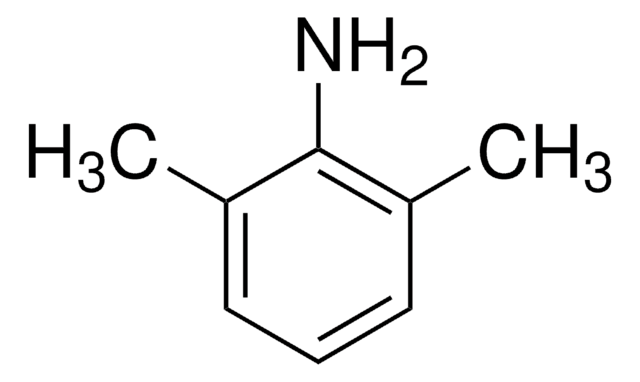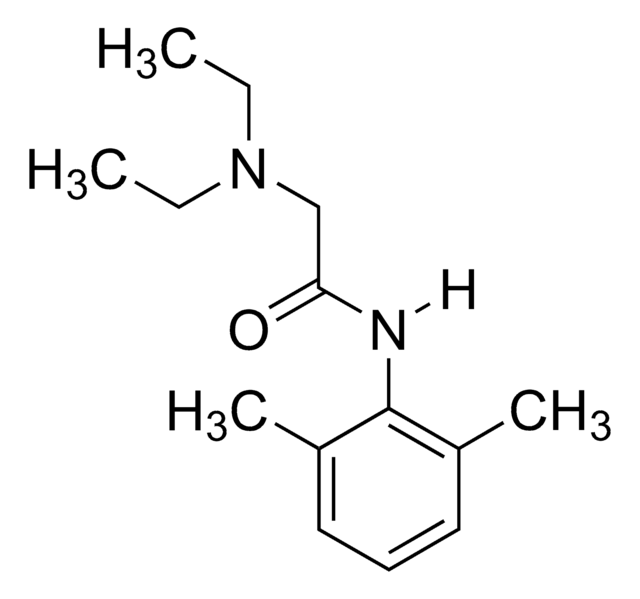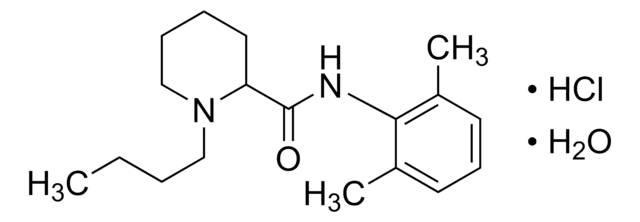1366002
USP
Lidocaine
United States Pharmacopeia (USP) Reference Standard
Synonym(s):
2-Diethylamino-N-(2,6-dimethylphenyl)acetamide, Lignocaine, Xylocaine
About This Item
Recommended Products
grade
pharmaceutical primary standard
API family
lidocaine
manufacturer/tradename
USP
technique(s)
HPLC: suitable
gas chromatography (GC): suitable
application(s)
pharmaceutical (small molecule)
format
neat
SMILES string
CCN(CC)CC(=O)Nc1c(C)cccc1C
InChI
1S/C14H22N2O/c1-5-16(6-2)10-13(17)15-14-11(3)8-7-9-12(14)4/h7-9H,5-6,10H2,1-4H3,(H,15,17)
InChI key
NNJVILVZKWQKPM-UHFFFAOYSA-N
Gene Information
human ... SCN10A(6336) , SCN11A(11280) , SCN1A(6323) , SCN2A(6326) , SCN3A(6328) , SCN4A(6329) , SCN5A(6331) , SCN7A(6332) , SCN8A(6334) , SCN9A(6335)
Looking for similar products? Visit Product Comparison Guide
General description
Application
Also used to prepare standard and system suitability solution for assay, identification and impurity analysis according to given below monographs of the United States Pharmacopeia (USP):
- Lidocaine
- Lidocaine Hydrochloride Topical Solution
- Lidocaine Hydrochloride Oral Topical Solution
- Lidocaine Hydrochloride Jelly
Biochem/physiol Actions
Analysis Note
Other Notes
related product
Signal Word
Warning
Hazard Statements
Precautionary Statements
Hazard Classifications
Acute Tox. 4 Oral
Storage Class Code
11 - Combustible Solids
WGK
WGK 3
Flash Point(F)
Not applicable
Flash Point(C)
Not applicable
Choose from one of the most recent versions:
Certificates of Analysis (COA)
Sorry, we don't have COAs for this product available online at this time.
If you need assistance, please contact Customer Support.
Already Own This Product?
Find documentation for the products that you have recently purchased in the Document Library.
Customers Also Viewed
Articles
The benefit of HILIC over traditional reversed-phase chromatography is two-fold for both sample introduction and analyte detection. First, the high acetonitrile concentration of HILIC mobile phases allows for direct analysis of precipitated plasma samples without the need for additional sample solvent exchange. Second, the high acetonitrile content provides increased analyte response in positive ESI MS detection.
Related Content
HILIC mobile phases consist of a high composition of acetonitrile, which facilitates the direct analysis of precipitated plasma samples without the need for additional sample solvent exchange.
Our team of scientists has experience in all areas of research including Life Science, Material Science, Chemical Synthesis, Chromatography, Analytical and many others.
Contact Technical Service










